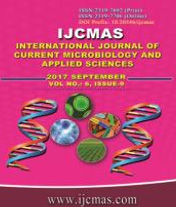


 National Academy of Agricultural Sciences (NAAS)
National Academy of Agricultural Sciences (NAAS)

|
PRINT ISSN : 2319-7692
Online ISSN : 2319-7706 Issues : 12 per year Publisher : Excellent Publishers Email : editorijcmas@gmail.com / submit@ijcmas.com Editor-in-chief: Dr.M.Prakash Index Copernicus ICV 2018: 95.39 NAAS RATING 2020: 5.38 |
Twenty three tomato genotypes were screened under field condition during two consecutive seasons of spring-summer (February to May) and autumn-winter (October to February). The differences in average day/night mean temperature/humidity of both the season were 15°C / 13.0°C and 46% / 39 %, respectively. Early flowering was observed in summer compared to winter season and diminution of pollen viability is noticed in all the genotypes during spring-summer whereas, in genotype Hisar lalit it was enhanced 0.92 times. Fruit set percent at high temperature is stringently reliant on proper gametogenesis (pollen and ovule development) and fertilization was markedly decreased in summer but this reduction was only 1.19 times observed in Hisar Lalit (Sel-18) in comparison to autumn-winter. The tomato plants in spring summer reveals stressed had significantly 1.6–2.5 times higher chl a/b ratio compared to autumn-winter. Chl b was degraded faster at high temperature than Chl a, represented by an increase in Chl a/b ratio with exposure. High temperature increased titrable acidity of tomato fruit and it was enhanced 1.30 to 1.03 times during spring summer. Heat Susceptibility Index (HSI) was used to measure stress tolerance in terms of minimizing the reduction in yield caused by unfavourable versus favourable environments. The ideal genotypes perform better yield in all environmental condition, therefore on the basis of HSI genotype PS-1(0.73), Hisar Lalit (0.77), EC-538455 (0.80) showed better performance and can be used for breeding purposes.
 |
 |
 |
 |
 |